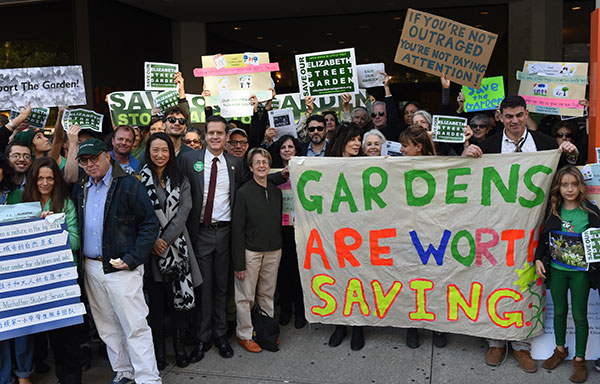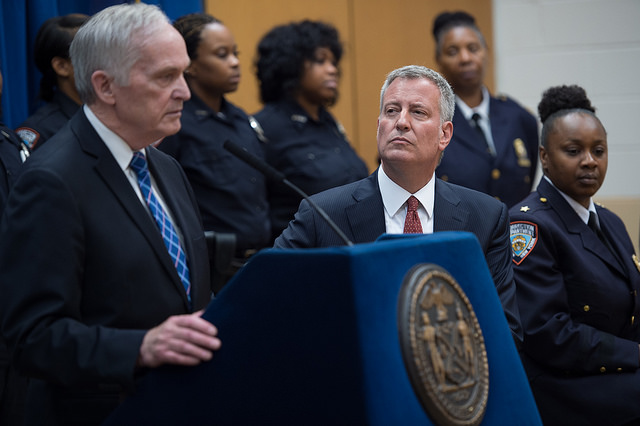Mayor Goes Quiet on Key Education Challenges

Mayor de Blasio at ABNY (photo: Edwin J. Torres/Mayor's Office)
If Bill de Blasio wants to be the Education Mayor, he needs to do better than this.
In Friday’s “Equity and Excellence” address sponsored by the Association for a Better New York before a generally well-heeled, overwhelmingly white audience, de Blasio discussed a list of programs that he’s largely been repeating for over a year.
We’ve heard it before and surely he can claim credit for planting seeds: Pre-K for All, Literacy for All, Algebra for All, Computer Science for All, AP for All, etc. Yet in most cases these are pilot programs with full implementation and assessment dates roaming well past the end of a possible second term for this mayor.
He claimed specious test score improvements long-disavowed by the State Education Department and others since last year’s and this year’s assessments were so markedly different. His speech even failed to mention the mayor’s signature Community Schools initiative and he rarely brought up Chancellor Carmen Fariña, perhaps signaling disappointment with both.
But more than that was missing.
The speech was notable for avoiding every hot button education issue facing the city, however relevant to his theme. Except for a guarded, meandering response to an audience question, the mayor never mentioned charter schools. Similarly, only when asked did the mayor defend Specialized High Schools like Bronx Science and Stuyvesant, never casting doubt on their unbalanced racial makeup and the selection process that he criticized during his 2013 campaign.
Never addressed were the opt-out movement, the Common Core, or State programs for “Renewal” and “Receivership” directed at struggling schools. Not once, in a speech on equity(!), was desegregation, diversity, or race called-out as an appropriate subject for mayoral attention.
Having been beat up on these issues, the mayor has backed down. His education agenda has been reduced to bromides about workforce and college preparation, creating strawmen he is ostensibly correcting, and – in his only shoutout to former Mayor Bloomberg – continuing to ensure school safety.
To be sure, the current Department of Education has made major changes in structure and practice. Superintendents and Field Support Services Centers have largely replaced Networks as mainstays of school support and oversight. School Report Cards are notable for de-emphasizing test scores, the Discipline Code has been revised so that restorative justice practices take priority over suspensions, and opportunities for positive parent/school interactions are way up.
But none of these, not the “for Alls” and not organizational tinkering, are worthy of an Education Mayor. Issue avoidance doesn’t build a legacy. The time for de Blasio to craft a vision that delivers on Equity and Excellence on a scale this city deserves, that its children deserve, is way overdue. “Racial and Economic Inequity” should be the topic of the mayor’s next education speech. Until then, he is thinking small and only repeating himself.
***
David C. Bloomfield is Professor of Education Leadership, Law, and Policy at Brooklyn College and The CUNY Graduate Center. The third edition of his book, American Public Education Law, is out now. On Twitter @BloomfieldDavid.
***
Have an op-ed idea or submission for Gotham Gazette? Email This email address is being protected from spambots. You need JavaScript enabled to view it.
Correcting the Record on the Misguided Plan to Develop Elizabeth Street Garden

photo: Friends of Elizabeth Street Garden
In response to City Council Member Margaret Chin’s op-ed column in Gotham Gazette published Oct. 6; from Friends of Elizabeth Street Garden President Jeannine Kiely and D. Kristin Shea:
Council Member Margaret Chin is our only elected official who supports developing Elizabeth Street Garden. She seems dead set on “winning” development of the Garden at all costs, even if it means giving up the opportunity to build five times more senior affordable housing at another nearby location within our community. In her attempts to sway public opinion, Council Member Chin has repeatedly released misleading information.
Allow us to correct the record:
FACT: NOT A PUBLIC PROCESS
Chin says she is “proud of the public process” and the “substantial amount of public review.” But her decision to build on Elizabeth Street Garden was a backroom deal at City Hall, without proper public review or discussion.
FACT: COMMUNITY IGNORED, DESPITE TREMENDOUS SUPPORT
Since learning about this secret deal in 2013, Manhattan Community Board 2 has held four public hearings, and overwhelming sentiment has been for saving the Garden, including support from every local elected official other than Chin and 16 parks and community organizations.
The Garden brings joy to thousands, including many seniors who live nearby. That’s why Mayor de Blasio, the city’s housing agency (HPD), and Chin received 5,000 letters in support of the Garden — far more than the “hundreds of letters” cited by HPD — and only one in support of the housing proposal from an organization that receives thousands of dollars each year through Chin.
FACT: BETTER AFFORDABLE HOUSING ALTERNATIVES EXIST
Chin claims that “identifying sites for affordable housing...can be a monumental challenge.” CB 2 took up that challenge and identified several alternative sites, including a vacant lot on Hudson and Clarkson streets where five times more senior housing can be built. Because this site was previously committed for parkland, it will not be available if Elizabeth Street Garden is destroyed.
In addition, a proposed project at 550 Washington St., currently being rezoned, will have 476 affordable units, including 178 for seniors.
We agree with Council Member Chin and the mayor that parking lots are “ripe for affordable housing development” and, therefore, encourage consideration of the garage on 2 Howard St. located in the heart of Little Italy, but outside the height-restrictive Special Little Italy District.
FACT: CHIN’S PROMISE THAT RESIDENTS CAN “AGE IN PLACE” IS MISLEADING
All residents of CB 2 receive preference for 50 percent of any senior housing built in the district, which extends from 14th Street to Canal Street and the Hudson River to Bowery. Remaining units would be available to anyone in the five boroughs. Preference is via lottery and applies only to the first round of rentals. Therefore, if 60 units were built on the Garden, as few as 30 residents currently living in all of CB 2 would live there, and possibly none from Little Italy.
FACT: 5,000 SF OF “PUBLICLY-ACCESSIBLE OPEN SPACE” IS A RUSE
The City is asking for proposals to create “lawns, trees, walks and planting and seating areas with a variety of sun and shade conditions, and also to provide for continuation of current educational and recreational programs and events,” all in an area the size of a basketball court, surrounded by seven-story buildings. When asked about building on Elizabeth Street Garden, former Parks Commissioner Adrian Benepe said, “It’s a very small site. You’d be shortchanging either one. I think the site is barely large enough for housing. You might be able to have a little sitting area.”
Ultimately, privately-owned public spaces often end up “inaccessible or devoid” of “amenities that attract public use,” or may be converted into retail space in the future, as Chin supported on Water Street.
Mayor Bill de Blasio is right when he said “Every New Yorker deserves access to clean, safe green spaces, no matter what neighborhood they live in.” Had Chin acted upon her declaration that “Communities must be consulted about changes coming to their neighborhoods,” Elizabeth Street Garden already would be a public park.
Instead of allowing politics to determine policy, we encourage Council Member Chin and the de Blasio administration to work with CB 2 and our elected officials to build more affordable housing and to preserve the precious little public green, open space we have left, for our seniors, our children and all the residents of our community.
***
by Friends of Elizabeth Street Garden President Jeannine Kiely and D. Kristin Shea. On Twitter @elizabethstgrdn. (Both Kiely and Shea are members of Community Board 2 but are not writing on behalf of CB 2.)
***
Have an op-ed idea or submission for Gotham Gazette? Email This email address is being protected from spambots. You need JavaScript enabled to view it.
Leading the Way on Ending Punitive Segregation

Commissioner Ponte, the author, & Mayor de Blasio (photo: Michael Appleton/Mayor's Office)
Today, the New York City Department of Correction formally ended the practice of punitive segregation for young adults ages 19 through 21 years old, resulting in the complete elimination of punitive segregation, which some call solitary confinement, for inmates ages 16 through 21 in our custody. This is an unprecedented milestone in New York State correctional history and, even more important, across the nation. To date, no other city or state has accomplished comparable punitive-segregation reforms for the 19-21 year-old age group.
As Commissioner of the NYC Department of Correction, I understand this has not been easy, and something that has required us to methodically implement, test, and refine options that ensure the safety of our staff and inmates. However, I am extremely proud of what our uniform and non-uniform staff have accomplished by reforming our punitive-segregation practices and policies.
When I became Commissioner in April 2014, there were almost 600 people in punitive segregation and a backlog of over 1,700 people. And violence in our jails was on the rise. On October 6, we had 124 inmates in all forms of punitive housing -- a reduction of nearly 80% over two years. We accomplished this by creating non-punitive, incentive-based alternatives to safely manage inmate behavior.
And we have done all this while still reducing violence in our jails.
We started our reforms even before the U.S. Attorney for the Southern District, Preet Bharara, issued a report in August 2014 that concluded that “DOC relies far too heavily on punitive segregation as a disciplinary measure” and before we negotiated the agreement in the federal lawsuit Nunez v. City of New York, which was approved by a judge in October 2015.
Through a raft of initiatives, we fundamentally transformed the use of punitive segregation for all age groups.
When we ended punitive segregation for adolescent inmates aged 16-17 in December 2014, and later, for 18-year-old inmates in June 2016, we created therapeutic alternatives to help them manage their behavior.
For the adolescents, these comprise Second Chance Housing and Transitional Restorative Units (TRU), which feature higher staffing levels – one officer to five inmates in Second Chance and one to two or even one to one in TRU. The officers in these units receive training on youth brain development, crisis prevention and management, and trauma-informed care practices for adolescents.
Inmates in these programs are afforded enhanced programming and counseling to better their life skills and job prospects and a behaviorally based incentive system enables them to earn privileges and commissary points.
For young adults aged 18-21, we have also created Second Chance and TRU units, but we have added two levels of management.
“Secure Housing” is designed to safely house young adults who are engaging in serious violence and assaultive behavior -- closely supervising them while providing individualized therapeutic programming for their behavioral needs.
For persistently violent young adult offenders, such as those who have seriously assaulted staff or stabbed or slashed other inmates, we have created special young adult units of Enhanced Supervision Housing, where inmates spend seven structured hours daily out of cell. Similar to adolescents, they are provided a behaviorally based incentive system that enables them to earn more privileges and eventually move back into the general population.
Using punitive segregation less means using it as a more targeted and meaningful tool.
Through rule-making with our partners at the Board of Correction, our oversight body, we have made punitive segregation more effective and fair.
Inmates no longer serve any time that was accrued during a previous incarceration. A tiered system ensures that only serious, violent infractions earn full punitive-segregation time.
With few exceptions, we have capped the maximum sentence to 30 days and have limited the number of days one can spend in segregation to 60 days in any single six-month period.
It’s a significant accomplishment to have done this while continuing to push a downward trend in violence throughout the Department through comprehensive reform.
In the first eight months of the year, from January to August, the most serious assaults on staff have dropped 40% compared to the same period last year. Overall assaults on staff dropped 17% in that period. Even one assault on our staff is one too many, so we have a lot of work to do, but the trend is moving in the right direction.
These reforms also increase inmate safety. Uses of force by officers on inmates that result in serious injury dropped by 40% in the first eight months of the year, largely because of our de-escalation training.
The bottom line is that, contrary to the assertions of some, you don’t need overwhelming numbers of inmates in punitive segregation to make jails safer. Heavy use of segregation does not prevent violence or deter it, particularly in the younger age groups. In fact, it may make matters worse. The latest research on brain development shows that punitive segregation is inappropriate for individuals aged 21 and under.
In New York, we are proud to have made history by ending punitive segregation for our youngest offenders and curtailing its overuse for all others – all while providing safer alternatives that support both staff and inmates.
***
Joseph Ponte is New York City Correction Commissioner. On Twitter @CorrectionNYC.
***
Have an op-ed idea or submission for Gotham Gazette? Email This email address is being protected from spambots. You need JavaScript enabled to view it.




